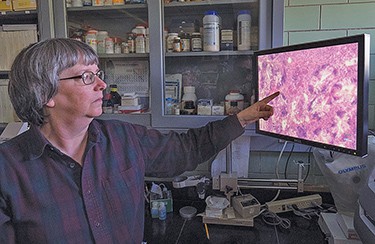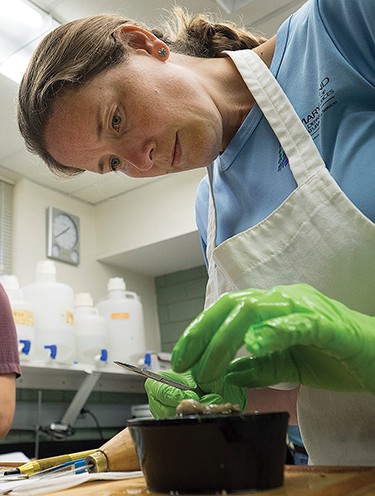By Timothy B. Wheeler, Bay Journal News Service
Oysters come to the Cooperative Oxford Laboratory for a checkup. But they never go home, even if they’re in peak health. They’ve sacrificed their goopy gray bodies to science.
The federal-state lab in the former fishing village of Oxford on Maryland’s Eastern Shore is where government scientists examine oysters and other fish for parasites, diseases and any other maladies that may be afflicting populations in the wild.
DNR biologist Laurinda Serafin Photo: Dave HarpThe low brick building was built in 1964, on the heels of a major oyster die-off in the Chesapeake Bay attributed in large part to a mysterious new disease called MSX. Since then, the lab has been engaged in a long-running effort in both Maryland and Virginia to track and understand MSX and another disease, Dermo.
Both are single-celled parasites that target oysters, but uncharacteristically can kill their hosts — in a matter of weeks, if infections are high enough. Dermo has been in the Bay since the 1940s, and is believed to have been introduced by the importation of seed oysters from elsewhere. MSX first popped up in Delaware Bay in 1957 and the Lower Bay two years later — how it’s transmitted remains unknown.
Both have repeatedly ravaged Chesapeake oysters over the last five decades, and remain a major concern for the future of the estuary’s keystone shellfish, which is a source of income for watermen, a prolific water filterer and a builder of reef habitat for other fish and aquatic creatures.
Hundreds of oysters collected by Maryland Department of Natural Resources biologists during their annual reef survey are brought to the lab every fall. Once there, tissue samples are taken and processed, with cross-sections of the animal sliced thinner than a human hair, then stained purple, pink and blue-black and studied under a microscope.
“You see this pink coloration?” pathologist Carol McCollough asked as she pointed to one slide showing the cross section of an oyster’s internal organs magnified on a screen. The small blot in the oyster’s intestinal tract indicated that its blood cells were responding to something foreign, she explained. “There’s MSX in that area.”

That’s a much less frequent sight in the oysters examined these days at Oxford and its counterpart at the Virginia Institute of Marine Science in Gloucester Point. Once a scourge of the Bay, especially its saltier waters, MSX has receded, and though still found infecting some oysters in some places — 11 percent on average in Maryland last year — it’s nothing like it used to be.
Dermo, on the other hand, remains widespread — nearly two-thirds of the oysters collected throughout Maryland’s part of the Bay in the fall of 2016 had it. But Dermo doesn’t appear to be as lethal as in the past, either.
“The trend that we’re really seeing is that the mortality consequences of those disease pressures seem to be fairly consistently less than they were in previous years,” said Chris Dungan, a DNR research scientist who oversees the Oxford lab’s oyster evaluations.
Although there’s no direct evidence, Dungan said he and others think that the decline in dead oysters found in surveys “reflects increasing resistance to those diseases… by the process of natural selection.”
Ryan Carnegie, Dungan’s counterpart at VIMS, said that although it’s largely circumstantial, he also sees evidence that oysters have developed resistance to becoming infected by MSX. And there are indications, he added, that they’ve developed an ability to tolerate Dermo without succumbing to it.
MSX was once rampant among oysters in the saltier Bay waters in Virginia, but now, Carnegie said, “we do not see much MSX at all…which suggests they are resisting the parasite from colonizing their tissues.”
Dermo levels seen by Virginia’s fall survey so far appear to be normal, Carnegie said, but it’s a relatively new normal. Disease levels the last decade or so have been higher than they were in the 1990s, he noted, the last time there was a major outbreak.
“The baseline for Dermo levels in the Bay has increased,” Carnegie said, “yet the oysters are doing better and better…They’re not allowing themselves to be completely overrun by the parasite.”
That’s a big deal, he added, because at its peak, MSX was killing 90 percent of the oysters it infected in the Bay, and Dermo was killing 70 percent of those it infected — every year.
One of Carnegie’s graduate students, Lauren Huey, is looking into another phenomenon that may be a byproduct of oysters’ growing ability to tolerate Dermo — though infected, they are ramping up their ability to reproduce.
Since 2003, around the time of the last major Dermo outbreak in the Bay, Carnegie said that research shows infected oysters have been able to increase their egg production.
“We don’t fully understand how they’re doing it,” he said, but it’s clear that oysters are living longer in the Bay than they used to. As a result of that longevity, they’re reaching bigger sizes and producing more eggs.
Carnegie cautioned that the Bay’s oysters aren’t going to be free of the specter of disease anytime soon.
“It’s still a dominant factor influencing oysters,” he said, “but the oysters are starting to regain control of the situation and they’re doing much better.
“This has taken decades, and it’s a long race,” he concluded. The key to continued progress may lie, he suggested, in protecting the continued survival of those oysters that apparently have the right genes to fend off or live with the diseases.
For Bay scientists and managers, Carnegie said, “It’s a matter of promoting policies that are going to help the oyster help itself as it fights these parasites.”
To some, that may sound like leaving a significant number of bigger, older oysters unharvested so they can produce offspring — the intent behind establishing sanctuaries.



